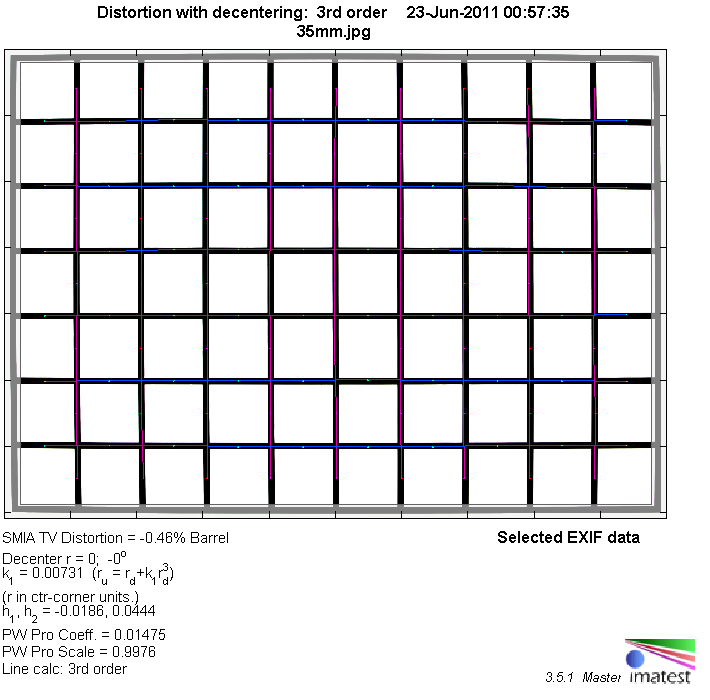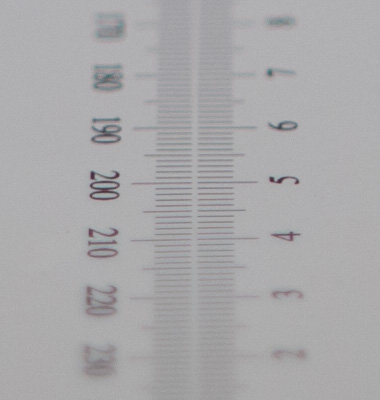|
Samyang 35mm f/1.4 AS UMC (EOS) - APS-C Format Review / Lab Test Report - Analysis |
|
Lens Reviews -
Canon EOS (APS-C)
|
|
Page 2 of 2

Distortion
The Samyang 35mm f/1.4 produces only a slight amount of barrel distortion (~0.5%) which isn't objectionable anymore.

Vignetting
The Samyang lens is a full format lens and as such it enjoys the usual sweet spot effect on APS-C DSLRs. However, the light falloff remains quite noticeable at max. aperture (~0.8EV). It's not an issue anymore at f/2 though and basically not detectable beyond.

MTF (resolution)
The resolution of the Samyang lens is pretty impressive. It is already very high f/1.4 and that's across the APS-C image frame. The level of contrast is somewhat reduced here though so if you require really snappy images you should go for f/2 instead. Stopping down does gradually improve the quality till reaching its truly excellent performance peak at f/5.6. Diffraction effects have a slight impact beyond but the lens remains fully usable at f/11. There's a slight amount of field curvature.
Please note that the MTF results are not directly comparable across the different systems!
Below is a simplified summary of the formal findings. The chart shows line widths per picture height (LW/PH) which can be taken as a measure for sharpness.
If you want to know more about the MTF50 figures you may check out the corresponding Imatest Explanations
Chromatic Aberrations (CAs)
Lateral CAs (color shadows) are quite low with an average pixel width of less than ~0.5px at the image borders. This is pretty impressive actually.

Bokeh
The quality of the bokeh (rendering of the out-of-focus blur) is, of course, a major aspect for an ultra-large aperture lens. The Samyang lens does not convince completely here. Out-of-focus highlights have a slightly nervous inner zone. The highlight shape remains pretty circular till about f/2.8 though. This nervousness in the highlights may also be a side effect of the background blur which isn't smooth either. The quality of the foreground blur is quite good though.

Bokeh Fringing
Bokeh fringing is a common problem among large aperture lenses. At f/1.4 and f/2 you may be able to spot purple halos in front and green halos beyond the focus point. The issue is reduced at f/2.8 and not really visible anymore at f/4.
You may notice that the focus shift (so-called "residual spherical aberrations) is quite minimal.
|
Move the mouse cursor over the f-stop marks below to observe the respective LoCAs
|
| f/1.4 |
f/2 |
f/2.8 |
f/4 |
|

|
Sample Images
You can check the sample image sections in our full format reviews (Canon + Nikon) of the lens.
Verdict
Samyang continues to surprise us regarding the quality of their recently released products. The full format Samyang 35mm f/1.4 AS UMC is capable of delivering a very high quality straight from f/1.4 - at least within the tested APS-C scope. The contrast level is a bit reduced at max. aperture though. Stopping down boosts the contrast whereas the resolution improves to excellent results at medium aperture settings. It may be a surprising news but this is somewhat superior to the mighty Canon EF 35mm f/1.4 USM L. There's a some vignetting at max. aperture but it's not an issue anymore at smaller apertures. Distortions are generally nothing to worry about. The quality of the bokeh is a bit on the nervous side but that's a fate that it shares with the Canon L lens actually. The amount of bokeh fringing is typical for a lens in this class.
We should mention that we had a bit of an issue with respect to white balancing on the EOS 50D - it varied somewhat across the aperture range. There were no issues on the EOS 5D II though nor on the Nikon cameras used for testing. So it's probably a issue related specifically to the EOS 50D.
The mechanical quality of the Samyang lens is on a very high level. It may not be a full-metal lens but the lens body is made of high quality plastics and it's a joy to use the damped focus ring. A limiting factor is certainly the lack of AF as well as the uncoupled aperture which forces photographers into a rather classic style of shooting again. Magnified live-view (or a split-image viewfinder screen) can help to overcome some of the focusing problems but it will slow you down for sure. However, keep in mind that the lens costs just a fraction of the corresponding Canon lens so its a fairly obvious choice for budget-oriented users with a desire for high speed (ultra-large aperture) and high quality images.
|